|
|
WHITE-CROWNED
BLACK
WHEATEAR
Oenanthe leucopyga
Kessingland 1982
by Andrew Easton
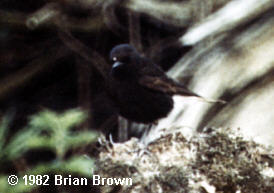 JUNE
4, 1982 STARTED OUT LIKE any other Friday and it very nearly ended
the same way, but two very fortunate events coincided to make it a
rather special day indeed. The first was that Mr and Mrs Tarry
from Kessingland decided to walk from Kessingland to Benacre that afternoon,
and the second was that it was the first Friday of the month which is the
meeting night of the Lowestoft RSPB local group.
JUNE
4, 1982 STARTED OUT LIKE any other Friday and it very nearly ended
the same way, but two very fortunate events coincided to make it a
rather special day indeed. The first was that Mr and Mrs Tarry
from Kessingland decided to walk from Kessingland to Benacre that afternoon,
and the second was that it was the first Friday of the month which is the
meeting night of the Lowestoft RSPB local group.
And so it came to pass that as I was talking to Roger Conner in the lecture theatre of Lowestoft Central Library a little after 6pm shortly before the meeting started, Mr and Mrs Tarry came up and asked us if it was possible that they could have seen a Black Wheatear O. leucura on the fence of the field just north of the Benacre Ness pumping station. As a conversation stopper this question could hardly be bettered; the phrase chin hitting the floor springs to mind as I'm sure we both stood there in a state of stunned amazement.
We soon recovered from the shock and started asking questions such as what did it look like, and where and when did you see it? From their description it was clear that there was little possibility of it being anything else, no matter how unlikely it seemed to be. The arrival of a Marmora's Warbler Sylvia sarda in Yorkshire the previous month had been equally unexpected. The time was now around 18:30 and with sunset at around 20:10 we decided we to skip the meeting to go and look for the bird, but with what? As we had come to an evening indoor meeting we were wearing full dude gear and sensible shoes, but more importantly our binoculars and telescopes were sitting uselessly at home.
We decided to ring Brian Brown to try to get at least one other person in on the search, after briefly retelling the tale we had just heard Brian was as interested as we were. It was agreed that we would set off from the Library in Rogerís car and pick up Brian en route, and that he would bring spare binoculars with him. We soon found him at the roadside clutching two pairs of binoculars, a telescope and a camera; the hunt was on.
After a seemingly endless journey we arrived in Kessingland, and as the light was already starting to fail we decided to drive through the holiday camp to save time. We soon arrived at the top of the field where the bird had been seen earlier in the afternoon, and set off along the fence line. Scanning ahead we could see no sign of any birds at all; our hearts sank, any birds must surely have gone to roost by now. Moments later though I spotted a small bird silhouetted against the skyline on a heap of earth around the edge of a pit in the middle of the field, and yes it was a wheatear. We hurried across the field to get the light behind us and there incredibly was a large, pot-bellied wheatear that was undeniably black!
We got an even bigger shock though when the bird flew out of the pit, there was no black bar on the tail tip, each side of the central black tail feathers was white to the tip. Closer inspection revealed a few black flecks at the tip. We thought Black Wheatear should have a black bar like a Northern Wheatear Oenanthe oenanthe but not having had time to check any books before we set out we were not absolutely certain about this.
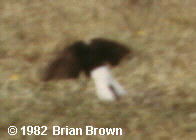 The
wheatear seemed quite tame and clearly favoured a rusty car chassis in the
salubrious surroundings of a rubbish-filled pit. Shortly after, it moved off
towards the pumping station. At this stage with a little light left Brian
felt it advisable to try to get a record shot of the bird and rather than
chase it around the field stationed himself in the pit opposite the chassis.
I volunteered to walk around behind the bird to gently persuade it to return
to the pit. It didn't take long, the bird seemed more than happy to oblige
and flew straight back to the old chassis where it posed for several shots
like a true professional. While we were watching the bird a holidaymaker staying
in Kessingland came up and asked us what it was as he had seen it there for
a couple of days and had assumed it was an aberrant Northern Wheatear!
The
wheatear seemed quite tame and clearly favoured a rusty car chassis in the
salubrious surroundings of a rubbish-filled pit. Shortly after, it moved off
towards the pumping station. At this stage with a little light left Brian
felt it advisable to try to get a record shot of the bird and rather than
chase it around the field stationed himself in the pit opposite the chassis.
I volunteered to walk around behind the bird to gently persuade it to return
to the pit. It didn't take long, the bird seemed more than happy to oblige
and flew straight back to the old chassis where it posed for several shots
like a true professional. While we were watching the bird a holidaymaker staying
in Kessingland came up and asked us what it was as he had seen it there for
a couple of days and had assumed it was an aberrant Northern Wheatear!
We then left the bird in peace and returned to the car happy in the knowledge that we had seen the first recent Black Wheatear to be recorded in Britain. Brian and Roger both commented that they had seen a small white spot on the forecrown of the bird when it had returned to the pit the last time, I had not noted this, but we didn't think too much of this as leucism is rife in black birds of many species. Little did we know what fate had in store for us.
When we got back to Lowestoft we went to straight to Brianís, he immediately phoned Cliff Waller whilst directing Roger and I to the field guides. When we turned to the wheatear plates we received a nasty shock for in both the Hamlyn and Collins field guides there was a broad black bar on the tail tip. We thought the Suffolk curse had struck again, remembering the ĎAmerican Cootí which had turned out to be a hybrid Coot Fulica atra x Moorhen Gallinula chloropus and the 'Sizewell Bunting' which had been initially reported as a Rock Bunting Emberiza cia before being re-identified as a hybrid Pine Bunting E. leucocephalos x Yellowhammer E. citrinella. Now we had a Black Wheatear with a wrong tail!
Browsing further through the Collins Field Guide I found a bird with the right tail pattern, it was from even further south and was called a White-crowned Black Wheatear, none of us had ever heard of it. Not only did its Saharan distribution make it seem very unlikely to be our bird it should also have a very striking white skullcap. I told them that the tail pattern matched a bird called a White-crowned Black Wheatear, but that it should also have a white crown, and then with a tremendous sense of relief I noticed a small thumbnail sketch tucked away under the main picture of a bird labelled as a juvenile, it's head was all black! We gathered round the hallowed page and all agreed it was definitely our bird, the tail pattern was perfect and the single white feather on the crown which Brian and Roger had seen only served to reinforce the identification.
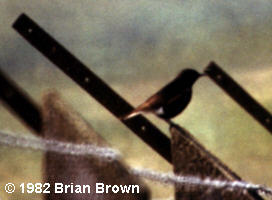 Brian
quickly relayed these details over the phone and armed with this news, and
having seen the species in the Middle East, Cliff Waller set off to try to
see the bird before dark to confirm our identification. He was indeed successful
and even saw it go to roost in one of the nearby bushes. Never was a phone
call more welcome, as he fully agreed with our identification.
Brian
quickly relayed these details over the phone and armed with this news, and
having seen the species in the Middle East, Cliff Waller set off to try to
see the bird before dark to confirm our identification. He was indeed successful
and even saw it go to roost in one of the nearby bushes. Never was a phone
call more welcome, as he fully agreed with our identification.
The news was then released to an unsuspecting birding community. As this was 1982 there were no Birdlines or pagers, only the word of mouth grapevine. Being late in the evening many people had already made prior arrangements for their birding weekend, some probably even disbelieved the report. Even so the next day saw a steady flow of people making the pilgrimage along the coast to see this very confiding individual, and I was able to finally see the white crown feather. That night it moved on, and like most vagrants before it was never seen again. It later transpired that a worker at the pumping station had seen it earlier in the week and it had probably been present since June 1st at least.
In light
of this occurrence a review of all the British and Irish records of Black
Wheatear was carried out by the British Ornithologists Union and all were
rejected, and so that species was removed from the British and Irish Lists.
The species has now occurred at least 12 times in Europe, including five records
in Cyprus. A table of these occurences and a map of their locations appear
below.
| COUNTRY | DATE OF OCCURENCE | REFERENCES |
| Malta | April 18, 1872 | (Sultana & Gauci 1982; Brown 1986; Lewington et al. 1991) |
| Cyprus | March 11-24, 1970 | (Bannerman & Bannerman 1971; Brown 1986; Lewington et al. 1991) |
| Spain | Two - May 28, 1977 | (Valverde 1978; Brown 1986; Lewington et al. 1991) |
| United Kingdom | June 1-5, 1982 | (Brown 1986; Lewington et al., 1991) |
| Cyprus | May 1985 | (Anon. 1994) |
| Germany | May 9-13, 1986 | (Anon. 1989; Lewington et al. 1991) |
| Cyprus | March 30, 1993 | (Anon. 1994) |
| Turkey | August 12, 1993 | (Sorace 1996) |
| Cyprus | February 22, 1999 | (Gantlett 2000) |
| Cyprus | April 12-23, 2000 | (Gantlett 2001) |
| Portugal | March 25, 2001 | (Gantlett 2002) |
| Croatia | August 1-4, 2001 | (Muzinic, 2002) |
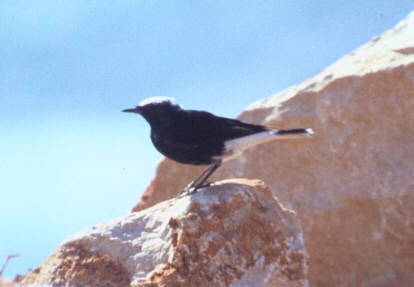 |
Pictured
to the left is the 2001 Croatian bird, which displayed rather more white
on the crown than our bird! © Jasmina Muzinic |
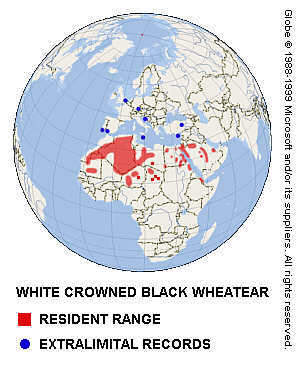 |
Britain still awaits a second record of White-crowned Black Wheatear, and there must be a good chance that it will occur again one day. After all, Marmora's Warbler has been recorded three more times in the UK since the first occurence in 1982, including on the Suffolk coast in May 2001. Several Suffolk birders are especially keen for a second chance as they were on holiday in Scotland at the time, all was not lost however as some of their wives went to see it on their behalf ! The
moral of this tale is that if you are going on holiday always take your
spouse with you, otherwise they may seriously grip you off! POSTSCRIPT If
it is any consolation to those who dipped this bird, the author missed
the Corton Alpine Accentor in Spring 2000 due to being on holiday, also
in Scotland. Though fortunately no member of my family went to see it
to grip me off; but plenty of the Lounge Lizards took great pleasure
in showing me the photographs and videos they took of the 'Dodgy Dunnock'
as I prefer to call it ! |
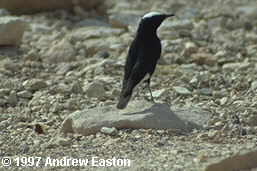 |
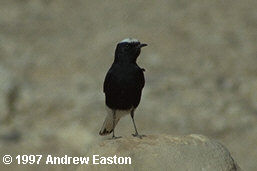 |
References:
Anon. 1989. Seltene Vogelarten in der Bundesrepublik Deutschland von 1977
bis 1986. Limicola 3(4):157-196.
Anon. 1994. European News. White-crowned Black Wheatear Oenanthe leucopyga.
British Birds 87 (1): 1-15.
Bannerman, D., Bannerman, W. M. 1971. Handbuck of the Birds of Cyprus and
Migrants of the Middle East. Edinburgh.
Brown, B. J. 1986. White-crowned Black Wheatear: new to Britain and Ireland.
British Birds 79 ( 5):221-227.
Cramp, Stanley (Chief editor) 1988, The Birds of the Western Palearctic: Vol
V. Oxford University Press.
Easton, A. 1998. Antique Rarities: White-Crowned Black Wheatear. Lounge Lizard
3. Lowestoft Bird Club, 22-24.
Gantlett, S. 2000. 1999: the Western Palearctic year. Birding World 13 (1):
15-32.
Gantlett, S. 2001. 2000: the Western Palearctic year. Birding World 14 (1):
16-43.
Gantlett, S. 2002. 2001: the Western Palearctic year. Birding World 15 (1):
13-34.
Lewington, I., Alstrom, P., Colston, P. 1991. A Field Guide to the Rare Birds
of Britain and Europe. Harper Collins.
Muzinic, J. 2002. First record of white-headed black wheatear (Oenanthe
leucopyga) in Croatia. Israel Journal of Zoology 48 (3): 247-248
Sorace, A. 1996. The first White-crowned Black Wheatear Oenanthe leucopyga
in Turkey. Sandgrouse 18 (1): 68.
Sultana, J., Gauci, C. 1982. A New Guide to the Birds of Malta. Malta.
Valverde, J. A. 1978. Prima cita de la Collalba Yebelica (Oenanthe leucopyga)
en la Peninsula Iberica. Donana Acta Vertebrata 5:109-110.
And thanks go to Jasmina
Muzinic, finder of the Croatian bird, for preparing the table of occurences,
and locating many of the references.
1998 (Revised
October 2003)